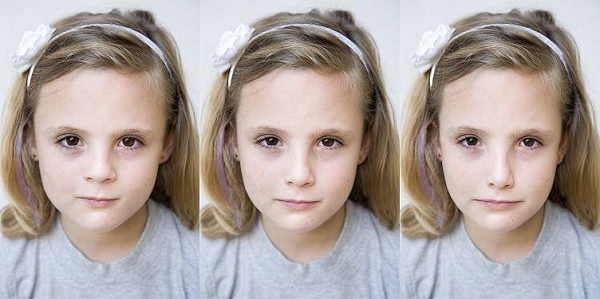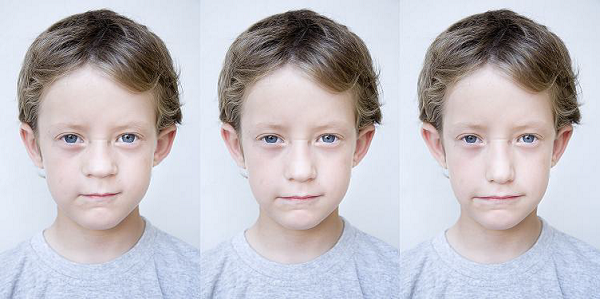Study Shows âA Wordâs Worth More Than a Thousand Picturesâ
Itâs known that âa pictureâs worth a thousand words.â But a new study begs to differ when it comes to young children and their influence on adults. But whatâs more important? How they look or what they say?

Children play an important role in ensuring that they are cared for by adults by using physical and cognitive cues. Since humans were hunters and gatherers, babies and young children have relied on adults to serve their caretaking needs. They used these physical and behavioral cues as potent attractants for adults at a time when their survival was strongly dependent on adult care â and these cues are still as powerful today.


Photo Caption: Bjorklund and his collaborators used a face-morphing software program to alter the images of a 6-year-old girl and boy to look younger and older for the study. The photos in the middle are the original images. Examples of the younger face are pictured to the far left and examples of the older face are pictured to the far right.
It is widely known that âa picture is worth a thousand words.â But a new study by researchers at Âé¶čŸ«Æ·ÊÓÆ” published in Evolutionary Psychology begs to differ when it comes to young children.
Children play an important role in ensuring that they are cared for by adults by using physical and cognitive cues. Since humans were hunters and gatherers, babies and young children have relied on adults to serve their caretaking needs, especially at a time when they faced a constant struggle for survival, competing for limited resources under harsh conditions. They used these physical and behavioral cues as potent attractants for adults at a time when their survival was strongly dependent on adult care â and these cues are still as powerful today. But whatâs more important in how they influence adults and elicit their nurturing spirit? Is it their physical features or what they say? Â
Prior research has shown the significant influence physical and cognitive cues have on adultsâ perceptions of young children. However, until now, these two cues have been studied independently. Researchers in FAUâs Charles E. Schmidt College of Science and their collaborators at the Universitat Juame I and Universidad de MĂĄlaga in Spain are the first to study childrenâs facial features and their expressions simultaneously to gauge adultsâ reactions. They have revealed that when it comes to young children, âone word is worth a thousand pictures,â and that words are more powerful than appearances in how adults feel about and respond to young children.
The aim of this study was to contrast adultsâ reactions toward two specific indicators of maturity status in children: physical maturity, reflected by faces with different degrees of maturity, and cognitive maturity, reflecting ânaturalâ cognition such as a child overestimating his or her abilities, and âsupernaturalâ cognition, such as when a child attributes animate characteristics to an inanimate object.
The researchers used four photos of boys and four photos of girls aged 6 years old as face stimuli. Using a face-morphing software program they altered the images to make them look younger (between 4Â and 7 years old) and older (between 8Â and 10 years old). They selected adjectives and statements they believed represented a wide range of characteristics that potentially play an important role in how adults interact with young children. Descriptors were classified into four factors: positive affect, negative affect, intelligence, and helpless. They generated five scenarios: mature face/mature vignette, face only, immature face/immature vignette, mature face/immature vignette, and immature face/mature vignette.
Participants in the study were asked to select which of the two hypothetical children (younger or older) best reflected a series of traits (cute, friendly, likely to lie, smart). A total of 36 versions of the questionnaires were created so that each face was associated with both natural and supernatural vignettes equally as often. Â
âOur results indicate that childrenâs thinking is the more important cue to their maturational status and attributions of positive and negative affect than facial appearance,â said David Bjorklund, Ph.D., professor of psychology in FAUâs College of Science. âAs children enter the preschool years, additional cues become available to assess a childâs maturational status, among them language and the type of cognitive abilities that children express via language. It is during this time that childrenâs verbalized thinking becomes the most reliable source of information for adults about childrenâs psychological characteristics, with physical appearance assuming a more secondary or complementary role.â
Overall results of the study clearly showed that for children of the ages depicted (ages 4 to 10), cues of cognitive immaturity played a more potent role in influencing adultsâ judgements than cues of physical immaturity. For the supernatural vignette, expressions of immature thinking (e.g. âthe sun didnât come out today because itâs angryâ) garnered a greater positive affect and greater helplessness for children with immature thinking regardless of whether or not these supernatural attributes were paired with an immature or mature face. Although the sex of the participants in the study was significant in several interactions, the absolute magnitude of these differences was small and patterns of responses were similar for both men and women in all conditions. Overall, these results reflect the significance of cognitive over physical information for understanding adultsâ evaluations of young children.
âFrom an evolutionary developmental perspective, our study shows that physical cues like big doe eyes, cherub-like cheeks and large round heads â typical baby traits â are more relevant to adults during infancy than during the preschool period,â said Bjorklund. âIn preschool, with the spoken language, the verbalized expressions of childrenâs thoughts become the principal cues influencing adultsâ perceptions.â
-FAU-
Tags: science | faculty and staff | research